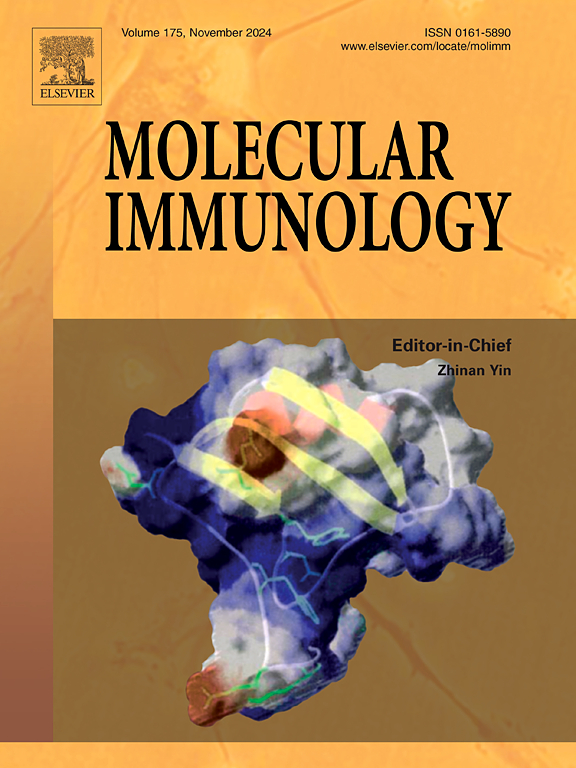Regulation of macrophage pyroptosis by SIRT1 during Pseudomonas aeruginosa-induced pneumonia
IF 3
3区 医学
Q2 BIOCHEMISTRY & MOLECULAR BIOLOGY
引用次数: 0
Abstract
Pseudomonas aeruginosa (PA), an opportunistic gram-negative bacterial pathogen, is the main cause of lung infections. Pulmonary infection induced by PA results in inflammatory lung injury characterized by macrophage pyroptosis. In our study, a mouse model of pulmonary infection was established by tracheal intubation with PA in vivo, and the MH-S macrophage line was stimulated with PA in vitro. HE staining was performed to observe changes in the lung tissue. The mechanism was further explored through various methods, including flow cytometry, LDH release assays, ELISA, real-time PCR, Western blotting (WB), and CCK8 assays. Additionally, the effect of MH-S cells on the proliferation of alveolar endothelial cells was observed by coculturing these two cell types. The results showed that PA-induced inflammatory injury in murine lung tissues increased the levels of inflammatory factors (IL-1β/6/12) and pyroptosis-related proteins (NLRP3, Caspase 1/11, and GSDMD-N) and promoted pulmonary macrophage pyroptosis. PA downregulated Sirt1 expression and increased p-NF-κB-p65 levels both in vitro and in vivo. Sirt1 activation or overexpression alleviated PA-induced lung tissue injury, inhibited macrophage pyroptosis, and decreased the expression of inflammatory factors and pyroptosis-related proteins. Sirt1 inhibition or knockdown critically strengthened the effect of PA on pulmonary macrophage pyroptosis. NF-κB inhibition suppressed the PA-induced increase in Sirt1-regulated pyroptosis in MH-S macrophages, decreased the levels of inflammatory factors and pyroptosis-related proteins, and weakened the inhibitory effect of MLE-12 cell proliferation on PA-infected MH-S cells. In conclusion, the Sirt1/NF-κB axis negatively regulates PA-induced inflammatory factor release and macrophage pyroptosis, promotes lung epithelial cell proliferation, and reduces inflammatory injury to the lung tissue.
SIRT1在铜绿假单胞菌诱导的肺炎中对巨噬细胞热亡的调控
铜绿假单胞菌(PA)是一种机会性革兰氏阴性细菌病原体,是肺部感染的主要原因。PA所致肺部感染可导致以巨噬细胞焦亡为特征的炎性肺损伤。本研究在体内用PA气管插管建立小鼠肺部感染模型,在体外用PA刺激MH-S巨噬细胞系。HE染色观察肺组织变化。通过流式细胞术、LDH释放法、ELISA、实时荧光定量PCR、Western blotting (WB)和CCK8等方法进一步探讨其作用机制。此外,通过两种细胞共培养,观察MH-S细胞对肺泡内皮细胞增殖的影响。结果表明,pa诱导的小鼠肺组织炎症损伤可提高炎性因子(IL-1β/6/12)和热噬相关蛋白(NLRP3、Caspase 1/11、GSDMD-N)水平,促进肺巨噬细胞热噬。PA在体外和体内均下调Sirt1表达,升高p-NF-κB-p65水平。Sirt1激活或过表达可减轻pa诱导的肺组织损伤,抑制巨噬细胞焦亡,降低炎症因子和焦亡相关蛋白的表达。Sirt1抑制或敲低可显著增强PA对肺巨噬细胞焦亡的作用。NF-κB抑制抑制了pa诱导的sirt1调控的MH-S巨噬细胞热亡的增加,降低了炎症因子和热亡相关蛋白的水平,减弱了MLE-12细胞对pa感染的MH-S细胞增殖的抑制作用。综上所述,Sirt1/NF-κB轴负调控pa诱导的炎症因子释放和巨噬细胞焦亡,促进肺上皮细胞增殖,减轻肺组织炎症损伤。
本文章由计算机程序翻译,如有差异,请以英文原文为准。
求助全文
约1分钟内获得全文
求助全文
来源期刊

Molecular immunology
医学-免疫学
CiteScore
6.90
自引率
2.80%
发文量
324
审稿时长
50 days
期刊介绍:
Molecular Immunology publishes original articles, reviews and commentaries on all areas of immunology, with a particular focus on description of cellular, biochemical or genetic mechanisms underlying immunological phenomena. Studies on all model organisms, from invertebrates to humans, are suitable. Examples include, but are not restricted to:
Infection, autoimmunity, transplantation, immunodeficiencies, inflammation and tumor immunology
Mechanisms of induction, regulation and termination of innate and adaptive immunity
Intercellular communication, cooperation and regulation
Intracellular mechanisms of immunity (endocytosis, protein trafficking, pathogen recognition, antigen presentation, etc)
Mechanisms of action of the cells and molecules of the immune system
Structural analysis
Development of the immune system
Comparative immunology and evolution of the immune system
"Omics" studies and bioinformatics
Vaccines, biotechnology and therapeutic manipulation of the immune system (therapeutic antibodies, cytokines, cellular therapies, etc)
Technical developments.
 求助内容:
求助内容: 应助结果提醒方式:
应助结果提醒方式:


